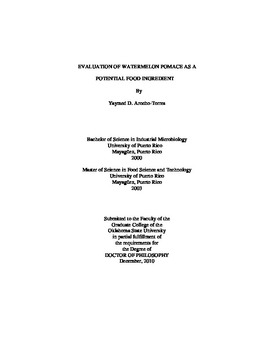| dc.contributor.advisor | Bellmer, Danielle | |
| dc.contributor.author | Arocho-Torres, Yaymed D. | |
| dc.date.accessioned | 2013-11-26T08:22:31Z | |
| dc.date.available | 2013-11-26T08:22:31Z | |
| dc.date.issued | 2010-12 | |
| dc.identifier.uri | https://hdl.handle.net/11244/6583 | |
| dc.description.abstract | Scope and Method of Study: | |
| dc.description.abstract | Watermelon fruit is the most consumed melon crop in the U.S., yet it is mostly consumed fresh since few value-added products exist. Watermelon is also the richest known source of the antioxidant lycopene. Pomace, which is the solid left after juice processing, could be used as a potential food ingredient. The objectives of this study were to evaluate the physicochemical properties of watermelon pomace and to compare the effect of different drying methods on its composition. Also, dried watermelon pomace was incorporated at different levels into flour to evaluate its effect on the rheological properties of the dough formed, as well as on the baking quality and sensory attributes of prepared cookies. Watermelons were juiced and the remaining pomace was dried using a cabinet dryer, a vacuum oven, and a drum dryer. The dried watermelon pomace was used to replace flour at 10, 20, and 30% in the preparation of cookies. | |
| dc.description.abstract | Findings and Conclusions: | |
| dc.description.abstract | Fresh pomace was found to have a lycopene content of 0.201 mg/g, 4.5 times higher than what has been reported for fresh watermelon, making it a concentrated source of lycopene. Lycopene loss occurred for all drying methods with drum drying causing a significant loss. In terms of color, drying resulted in an increase in L* and b* values and a decrease in a* values. Vacuum/cabinet drying was the best method in terms of preserving the color and lycopene content of watermelon pomace. However, it wasn't the most efficient or cost-effective, making the cabinet dryer the second-best option. | |
| dc.description.abstract | Rheological evaluation using a farinograph showed that adding pomace increased dough stability and time to break down, which suggests that it made it stronger. Cookies were not affected significantly in terms of spread and texture, although color became darker with increasing amounts of watermelon pomace. Cookies with 10% pomace were not scored significantly different from control cookies in terms of appearance and taste. Addition of pomace increased the lycopene content of the cookies, and even though there was some degradation during baking, the final products were good sources of the nutrient. This study showed that dried watermelon pomace could be used as a potential food ingredient to increase lycopene content and to substitute sugar in bakery products. | |
| dc.format | application/pdf | |
| dc.language | en_US | |
| dc.rights | Copyright is held by the author who has granted the Oklahoma State University Library the non-exclusive right to share this material in its institutional repository. Contact Digital Library Services at lib-dls@okstate.edu or 405-744-9161 for the permission policy on the use, reproduction or distribution of this material. | |
| dc.title | Evaluation of watermelon pomace as a potential food ingredient | |
| dc.contributor.committeeMember | Rayas-Duarte, Patricia | |
| dc.contributor.committeeMember | Maness, Niels | |
| dc.contributor.committeeMember | McGlynn, William | |
| osu.filename | Arocho_okstate_0664D_11209.pdf | |
| osu.accesstype | Open Access | |
| dc.type.genre | Dissertation | |
| dc.type.material | Text | |
| dc.subject.keywords | bakery products | |
| dc.subject.keywords | drying | |
| dc.subject.keywords | lycopene | |
| dc.subject.keywords | pomace | |
| dc.subject.keywords | watermelon | |
| thesis.degree.discipline | Food Science | |
| thesis.degree.grantor | Oklahoma State University | |
